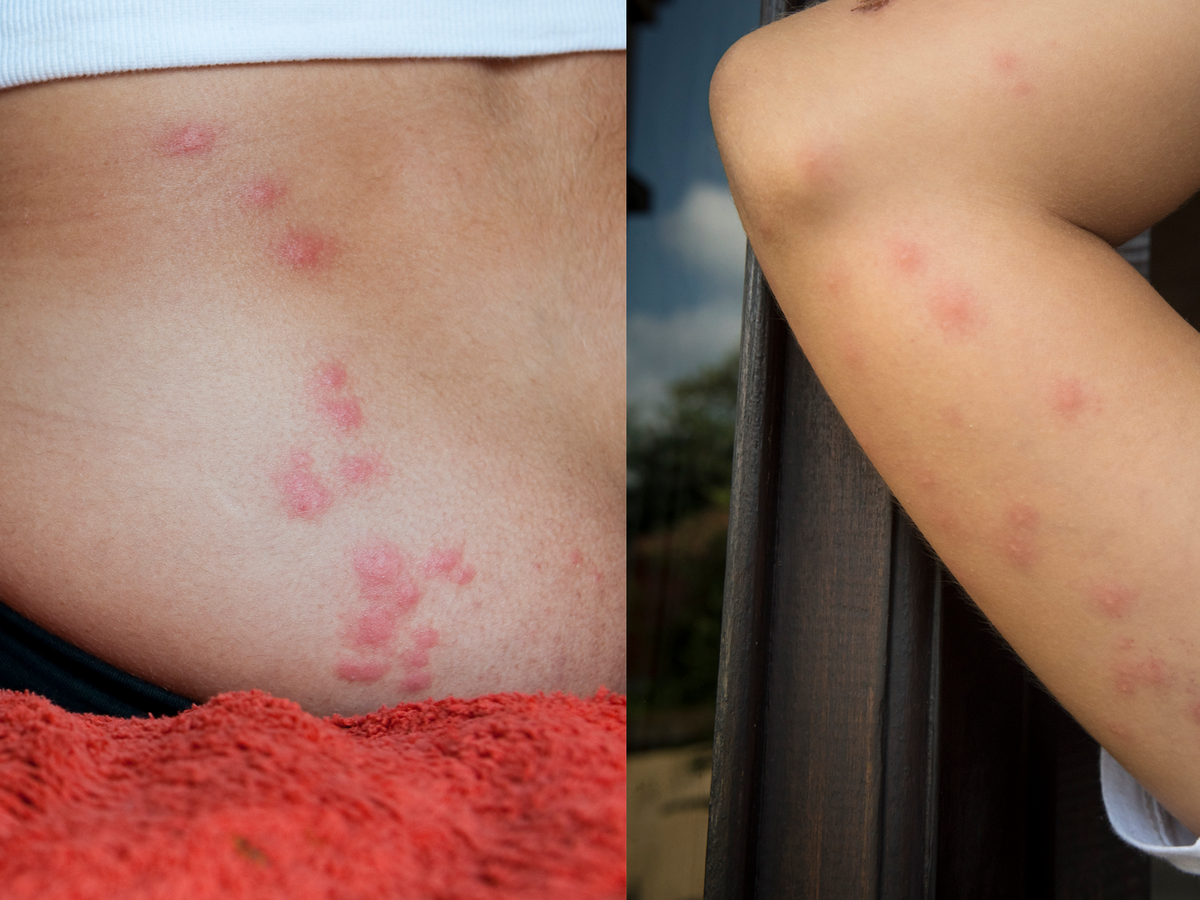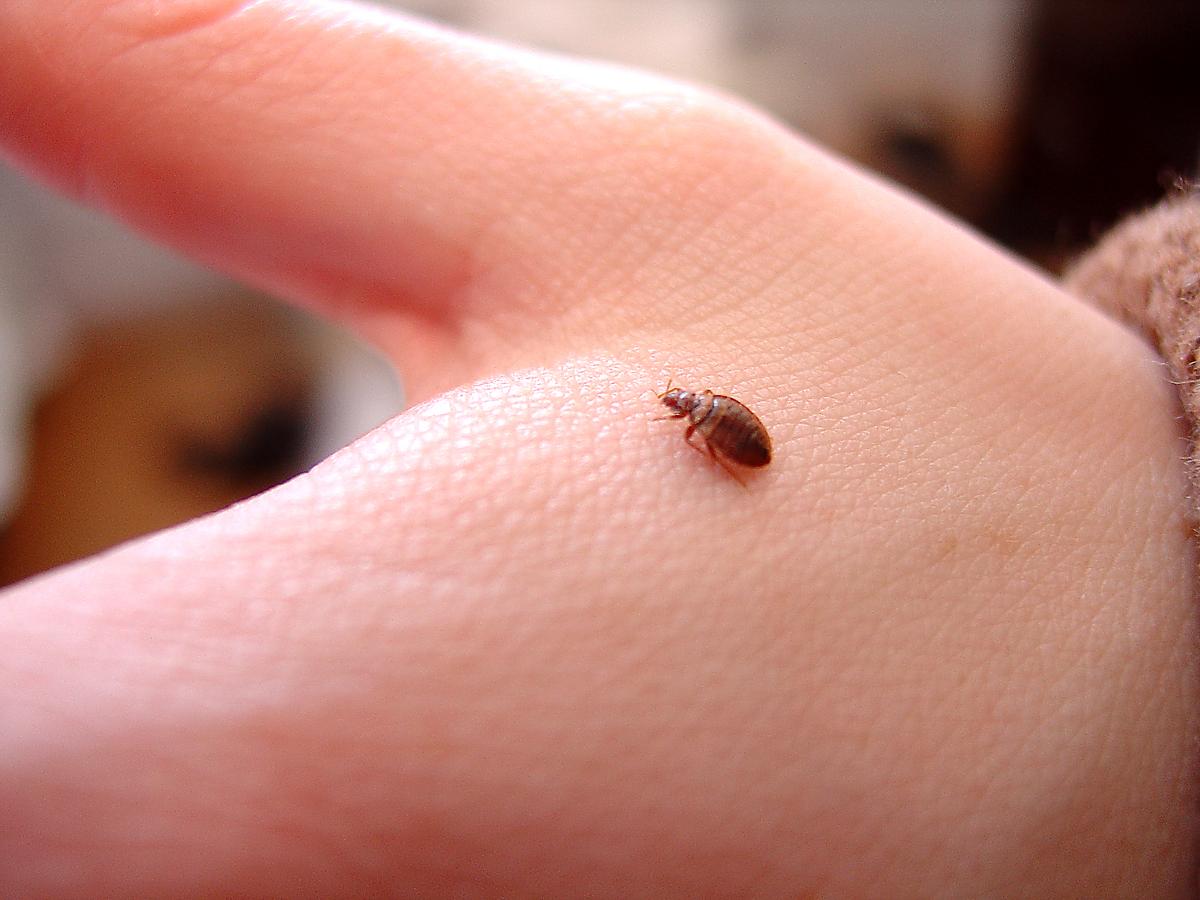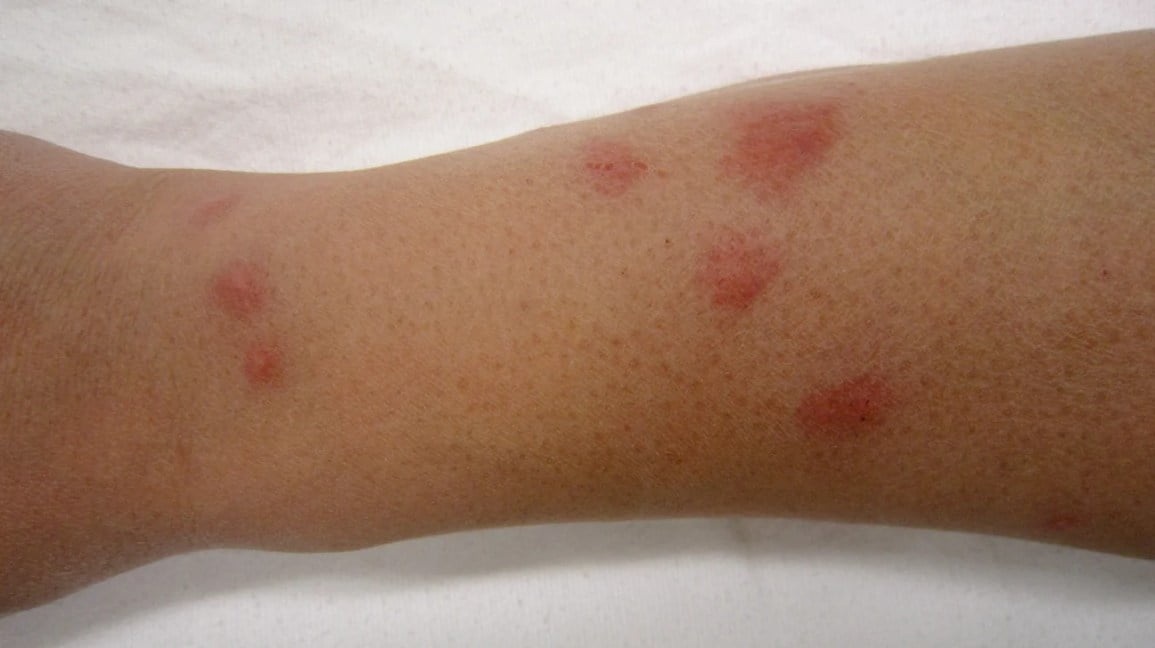To check for bed bug bites, look for small, red, itchy welts in a line or cluster on exposed skin. Detecting bites often occurs upon waking, as bed bugs typically feed at night.
Bed bug infestations can turn a peaceful sleep into a nightmarish ordeal. Spotting bed bug bites is crucial for early intervention and control. These nuisances leave distinct marks that may resemble other insect bites but have unique characteristics. Usually, their bites manifest as itchy red bumps and tend to appear on skin areas left uncovered while sleeping.
Knowing the signs of their presence is the first step in addressing a possible infestation. Timely identification not only aids in getting rid of these pests but also minimizes the risk of severe allergic reactions and skin infections. Bed bug bites also cause emotional distress, making prompt detection and treatment essential for peace of mind and health.

Credit: www.medicalnewstoday.com
Spotting Bed Bug Bites
Welcome to our guide on ‘Spotting Bed Bug Bites.’ No one wants to think about the possibility of bed bugs, but knowing how to identify their bites can arm you with the knowledge to act fast.
Identifying Bite Marks
Bed bug bites can look like little red spots on your skin. Often, these bites are arranged in a line or cluster. They occur mostly on parts of the body that are more likely to be exposed during sleep, like the arms, legs, and face.
- Small red bumps or welts in a zigzag pattern or a line
- Clusters of bites, or grouping
- Small, flat or raised areas that may become inflamed, red, or itchy
While these signs can point to bed bugs, other insects can cause similar marks. It’s crucial to check for actual bed bugs to confirm the infestation.
Symptoms Of Bed Bug Bites
Bed bug bites can cause more than just red bumps. Look for the following symptoms:
| Symptom | Description |
|---|---|
| Itchiness | Often an immediate reaction to a bite |
| Redness | Around the bite area, sometimes with a darker red spot in the middle |
| Swelling | Can vary from slight to significant |
| Localized Pain | Particularly with multiple bites |
Symptoms may appear several days after the bites and can mimic signs of more serious conditions or other bug bites. Consult a doctor if you experience a severe reaction.
Bed Bug Bite Patterns
Waking up with itchy welts on your body could be a sign of bed bug bites. These pesky critters feed at night, leaving distinctive marks on your skin. Recognizing bed bug bite patterns is key to differentiating them from other insect bites. It’s time to learn the common signs so you can act swiftly!
Clustered Vs. Isolated Bites
Bed bugs tend to leave bites that follow a pattern. Here’s how to tell the difference between clustered and isolated bites:
- Clustered bites appear as a group or line. They occur because a bed bug feeds multiple times in one area.
- Isolated bites are single, separate bite marks. These are less common and may happen if the bug is disturbed while feeding.
Common Bite Locations On The Body
Bed bugs target exposed skin while you sleep. Familiar spots include:
| Body Part | Likelihood of Bites |
|---|---|
| Arms and Shoulders | High |
| Legs and Feet | High |
| Face and Neck | Medium |
| Hands and Fingers | Medium |
Identify bed bug bites and find relief sooner. Remember to check sleeping areas regularly and take preventive measures to ensure these unwelcome guests don’t bite again!
Comparing Bites: Bed Bugs Vs Other Insects
Welcome to the insightful journey of identifying bed bug bites among other insect bites. Knowing the subtleties can make all the difference in managing your home’s pest control effectively. Let’s unveil the tell-tale signs that distinguish these pesky critters’ bites from others.
Differences From Mosquito Bites
Bed bug bites and mosquito bites can appear similar at first glance, but subtle differences exist:
- Appearance: Bed bug bites often present in a line or cluster, while mosquito bites are more isolated.
- Location: Bed bug bites typically occur on exposed skin during sleep, such as the arms, neck, or face.
- Reaction Time: Mosquito bites usually cause immediate itching, whereas bed bug bites may take longer to develop symptoms.
Distinguishing From Flea Bites
Differentiating between flea bites and bed bug bites often puzzles homeowners:
- Size: Flea bites are smaller and have a central red spot.
- Pattern: Fleas bite randomly, not in a straight line or close cluster like bed bugs.
- Location: Fleas often bite around the ankles and legs; bed bugs target any exposed skin during sleep.

Credit: www.prevention.com
Timing Of Symptoms
The ‘Timing of Symptoms’ after a bed bug bite varies greatly. Recognizing the timing helps with treatment and peace of mind. There are immediate reactions and delayed responses to consider. Each response offers clues about the presence of pesky bed bugs.
Immediate Reactions Vs Delayed Responses
Reactions to bed bug bites differ from person to person. Some people notice bites right away. Others don’t see anything for days. It’s important to know both types of reactions.
- Immediate Reactions: These appear within minutes. Redness and itching are common. Swelling may also occur.
- Delayed Responses: These can take days to show up. Some people don’t react at all. This makes detecting bed bugs difficult.
Duration Of Bite Marks
The length of time bite marks stay on the skin can be telling. Knowing this duration helps plan treatment steps. Pay attention to how long the marks last.
| Type of Bite | Duration |
|---|---|
| Small Bumps | A few hours to several days |
| Red Welts | Several days to two weeks |
| Severe Reactions | Up to several weeks |
Keep an eye on any bite marks. Marks that last more than two weeks may need medical attention. Don’t wait too long to seek help.
Complications And Risks
Discovering bed bug bites can be unsettling, not only for the discomfort they can cause but also due to potential complications. Complications and Risks associated with bed bug bites are real concerns. Individuals may experience varied reactions, from mild annoyances to more severe health issues.
Secondary Infections
Scratching is a natural response to the itchiness of bed bug bites. Scratching can break the skin, leading to infections. Keep an eye out for these signs of infection:
- Increased redness and swelling
- Pus or discharge
- Warmth around the bite area
- Fever or chills
Seek medical attention if these symptoms arise. It helps prevent infections from worsening.
Allergic Reactions To Bites
An allergic reaction to bed bug bites is rare but can be serious. Signs of an allergic reaction include:
| Symptom | Description |
|---|---|
| Hives | Raised, red, itchy welts on the skin |
| Difficulty Breathing | Shortness of breath or wheezing |
| Swellings | Swollen face, lips, or tongue |
| Dizziness | Feeling faint or lightheaded |
If you experience any of these symptoms, contact a doctor immediately. Timely medical intervention is crucial.
Self-care For Bed Bug Bites
Discovering you’ve been bitten by bed bugs can be an unsettling experience. The small, red, and often itchy welts serve as a nuisance. But worry not! Effective self-care can alleviate symptoms. Here’s how you can take matters into your own hands and find relief from bed bug bites right at home.
Home Remedies For Relief
Simple remedies can soothe the itchiness and discomfort caused by bed bug bites. Home treatments include:
- Washing the bites with soap and water reduces the risk of infection.
- Applying a cool cloth or ice pack can ease swelling.
- Baking soda and water make a paste that, once applied, can decrease itching.
- Aloe vera, either fresh or from a gel, is known for its soothing properties.
- Over-the-counter anti-itch creams, such as hydrocortisone, provide quick relief.
- Antihistamines, taken orally, can help control allergic reactions.
It’s crucial to avoid scratching the bites to prevent infection and promote healing. Keeping your fingernails trimmed can help in this regard.
When To Seek Medical Attention
Bed bug bites typically heal on their own. Yet, there are scenarios where it’s essential to consult a healthcare provider. Signs include:
| Sign | Explanation |
|---|---|
| Allergic Reaction | Difficulty breathing or severe rash. |
| Severe Itchiness | Extreme discomfort leading to sleeplessness. |
| Infected Bites | Oozing pus or increasing redness around bites. |
Prompt medical advice can avert complications. The doctor might prescribe stronger medications or advise further interventions.
Preventing Future Bites
Preventing future bed bug bites is crucial once you’ve identified that you’ve been a victim. These itchy, often painful bites can disrupt sleep and spread quickly if not addressed. Let’s explore effective strategies to keep yourself bite-free, focusing on both at-home precautions and tips for when you’re on the move.
Protective Measures At Home
- Encase your mattress and box springs with special bed bug-proof covers, which trap bugs inside and prevent new ones from settling in.
- Maintain a clutter-free environment, giving bed bugs fewer places to hide.
- Conduct regular inspections of your bedding, furniture, and nearby crevices, using a flashlight and magnifying glass.
- Vacuum frequently to remove any potential bed bugs or eggs.
- Seal cracks and crevices in walls and floors to eliminate bed bug entry points.
- Consider interceptor cups under bed posts, which can capture bed bugs attempting to climb up.
Bed Bug-proofing While Traveling
- Always inspect your hotel room carefully. Check the mattress, headboard, and furniture for signs of bed bugs.
- Keep luggage on metal racks or in the bathroom to reduce the risk of bugs crawling into your things.
- Use sealable plastic bags for your clothing and belongings, especially if you detect signs of bed bugs.
- On returning home, launder clothes immediately on a hot cycle to kill any bugs that may have hitched a ride.

Credit: www.orkin.com
Professional Pest Control Interventions
Finding bites on your body could signal a bed bug issue. It’s important to confirm if these pests have made your home theirs. After spotting signs or suffering bites, professional pest control may be the next step. Experts can tackle the infestation efficiently and prevent future occurrences.
Identifying An Infestation
Look for these signs:
- Unusual bites: Small, itchy, and red marks on your skin when you wake.
- Spotting bugs: Reddish-brown insects in mattress seams or furniture joints.
- Stains: Dark spots on your bedding that may be bed bug excrement.
- Eggs: Tiny, pearl-white eggs in hidden spaces near your sleeping areas.
Choosing The Right Pest Control Service
Here’s how to select a pest control service:
- Check credentials: Ensure the company holds proper licenses.
- Read reviews: Look for positive feedback and successful case studies.
- Ask about techniques: They should use safe, proven methods.
- Guarantee policy: Choose services with a promise of effectiveness.
Selecting a qualified pest control service is crucial. An expert team uses effective, safe interventions. They offer guarantees for their work, ensuring a bed bug-free environment.
Frequently Asked Questions Of How To Look For Bed Bugs Bites?
How Do You Know If Bites Are From Bed Bugs?
Bed bug bites often appear as small, red, itchy welts in a line or cluster. They mainly occur on exposed skin during sleep. Check for signs of bed bugs in your bedding and mattress seams.
What Do Bed Bug Bites Look Like On Human Skin?
Bed bug bites appear as small, red, and often clustered or lined bumps on the skin, usually resulting from nighttime feeding. They can cause itching and discomfort.
How Do You Check Yourself For Bed Bugs?
To check for bed bugs, examine your bedding, seams of mattresses, and nearby furniture for tiny brown insects or reddish stains. Use a flashlight for better visibility and inspect all crevices closely.
Can You Get Bed Bug Bites But Can’t Find Bed Bugs?
Yes, it’s possible to experience bed bug bites even if you can’t find the actual bed bugs, as these pests can hide in very small cracks and crevices.
Are Bed Bug Bites Always Visible and Easy to Identify?
Identifying bed bug infestation symptoms can be tricky, as bed bug bites are not always visible or easy to identify. Some people may not have any reaction to bed bug bites, while others may develop itchy red welts. Additionally, bed bug bites can be easily mistaken for bites from other insects, making it challenging to accurately identify them.
Conclusion
Recognizing bed bug bites is crucial for a timely response. Spotting signs early facilitates quick action to eradicate these pests. Remember, patterns and itchiness often signal their presence. For infestations, consult professionals. Stay vigilant and tackle bed bug concerns promptly for peace of mind at home.
{ “@context”: “https://schema.org”, “@type”: “FAQPage”, “mainEntity”: [ { “@type”: “Question”, “name”: “How do you know if bites are from bed bugs?”, “acceptedAnswer”: { “@type”: “Answer”, “text”: “Bed bug bites often appear as small, red, itchy welts in a line or cluster. They mainly occur on exposed skin during sleep. Check for signs of bed bugs in your bedding and mattress seams.” } } , { “@type”: “Question”, “name”: “What do bed bug bites look like on human skin?”, “acceptedAnswer”: { “@type”: “Answer”, “text”: “Bed bug bites appear as small, red, and often clustered or lined bumps on the skin, usually resulting from nighttime feeding. They can cause itching and discomfort.” } } , { “@type”: “Question”, “name”: “How do you check yourself for bed bugs?”, “acceptedAnswer”: { “@type”: “Answer”, “text”: “To check for bed bugs, examine your bedding, seams of mattresses, and nearby furniture for tiny brown insects or reddish stains. Use a flashlight for better visibility and inspect all crevices closely.” } } , { “@type”: “Question”, “name”: “Can you get bed bug bites but can’t find bed bugs?”, “acceptedAnswer”: { “@type”: “Answer”, “text”: “Yes, it’s possible to experience bed bug bites even if you can’t find the actual bed bugs, as these pests can hide in very small cracks and crevices.” } } ] }
I’m MD Tanvir, and I bring years of expertise gained from working closely with pest control companies to the forefront. My journey in the industry has inspired me to launch Bug Battler, a platform aimed at equipping people with the know-how to combat pests autonomously. Through Bug Battler, I aim to empower individuals with practical insights to tackle pest infestations effectively.

